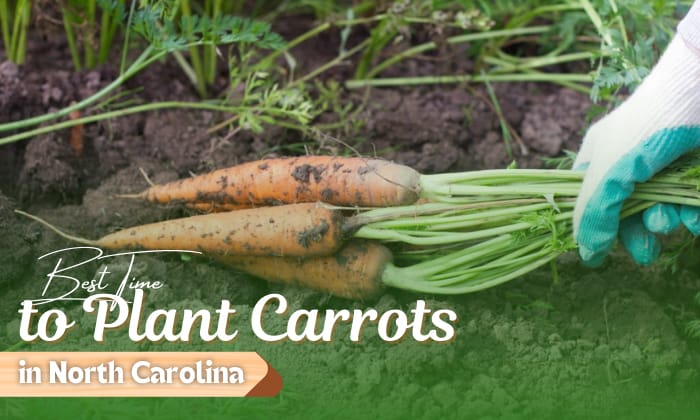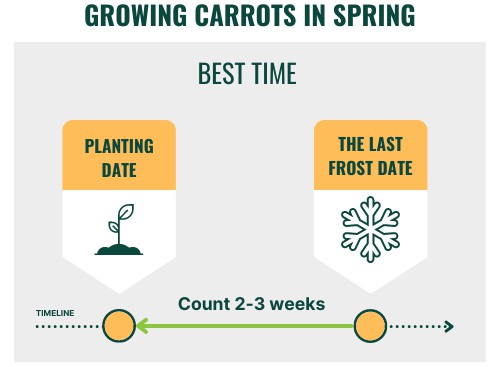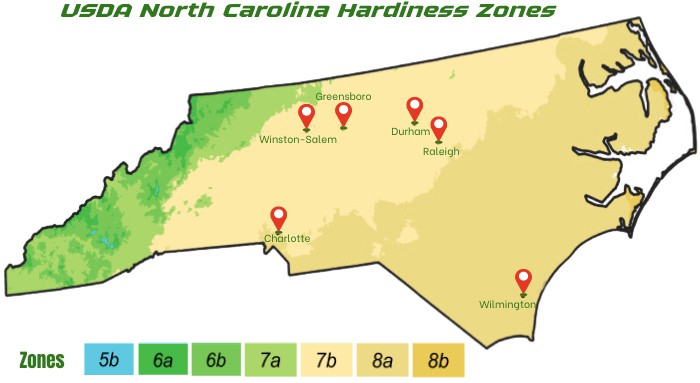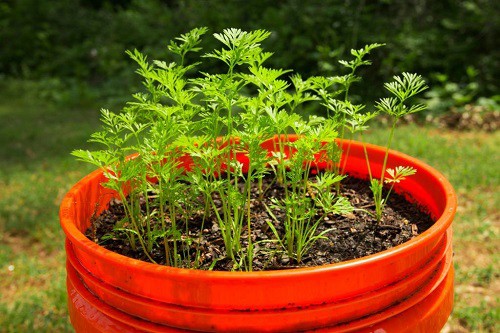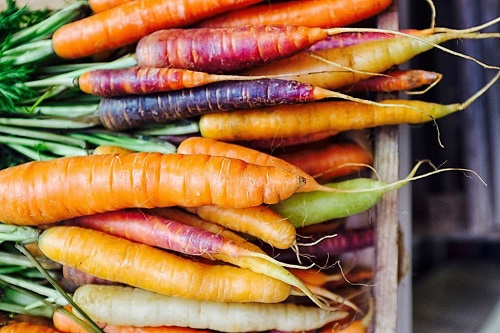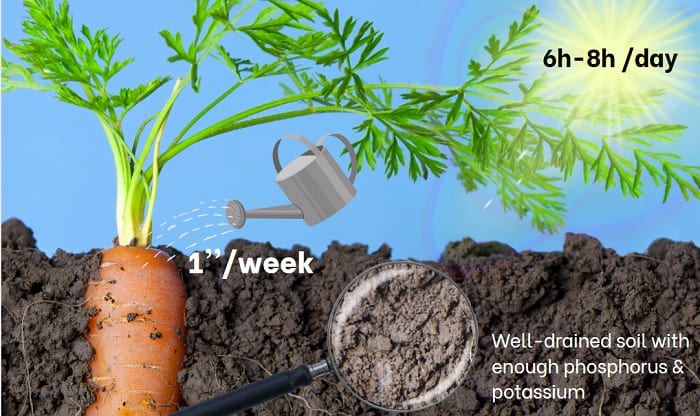Carrots are healthy home staples packed with vitamins and antioxidants. Depending on the place, climate, and soil they are grown, their color, size, and taste vary.
Carrots long for cool seasons to grow healthily. Thus, North Carolina’s moderate climate is ideal for their cultivation. The perfect time to sow these vegetables is around mid February to April in spring and August in the fall.
Keep reading to learn when to plant carrots in North Carolina and more!
Table of Contents
Points to Consider When Growing Carrots in North Carolina
1. Planting Time Based On Frost Date
Carrots are considered a cool-season crop. Prolonged heat above 86°Fcan hinder growth and reduce the quality of the produce. Achieving a successful carrot harvest relies heavily on knowing the accurate planting time.
- During spring, sow carrot seeds about 2–3 weeks before the last spring frost date, around mid-February to April.
- Meanwhile, seeds are sown in late summer when the temperature starts to drop, around ten weeks before the first frost. This way, the carrots will have enough time to grow for a harvest in the fall.
Refer to this table to determine the frost dates!
Last Spring Frost and First Fall Frost Dates
| Cities in North Carolina | Last Spring Frost Date | Spring Sowing | First Fall Frost Date | Summer Sowing |
| Charlotte | April 5 | March 15 – 22 | October 30 | August 21 |
| Raleigh | April 3 | March 13 – 20 | November 7 | August 29 |
| Asheville | April 13 | March 23 – 30 | October 26 | August 17 |
| Durham | April 9 | March 19 – 26 | November 1 | August 23 |
| Greensboro | April 5 | March 15 – 22 | October 31 | August 22 |
2. USDA Hardiness Zone
Depending on the USDA Hardiness Zone of the places in North Carolina, the spring and fall schedule may vary. This table will give you the perfect planting season based on your zone.
| USDA Hardiness Zone | Spring Planting Time | Fall Planting Time |
| Zone 5 | April to June | August to Mid-October |
| Zone 6 | April to June | August to October |
| Zone 7 | March to Mid-June | August to October |
| Zone 8 | Mid-February to May | Mid-August to Mid-November |
Carrot seeds are usually sown once the soil temperature has reached at least 40°F (4.4°C). Meanwhile, germination takes place in ideal temperatures of 55-65°F (12.8-18.3°C) but does not exceed 75°F (23.9°C).
Carrots require a USDA Hardiness Zone of 2-12 to thrive. Luckily, North Carolina falls within zones 5B-8B, making it an excellent place for successful carrot cultivation.
3. Carrot Planting Method
Direct Sowing
Most carrot farmers prefer carrots to be directly sown to the ground because transplantation tends to disturb the roots.
- Before planting, dampen the soil to prevent tiny seeds from being blown away.
- Place your seeds on the seedbed and sprinkle ¼ -½ inch of loose soil.
- Sow the seeds 2 inches apart or thin the seedlings out to a spacing of 2-3 inches later.
- Distance the rows to 6-8 inches apart.
- To avoid over-sowing, carefully sow just one or two seeds at a time.
- Keep the top one inch of the soil consistently moist until the seeds germinate.
Container Carrots
Although carrots are traditionally planted in the ground, growing carrots inside a container is also possible. This is an effective method to avoid pests like carrot flies and make it easier to control the plant’s environment.
- Ensure your pots are wide and at least 10-12 inches deep.
- Use a low-fertility potting mix for the soil and sprinkle the seeds sparingly over the top.
- Water the seeds, label the pot, and put it in a sunlit area.
- Irrigate the seeds regularly with a fine spray.
- Once the seedlings sprout, thin them out to 2 inches apart.
4. Carrot Varieties Suitable in North Carolina
- Chantenay Red Core– this carrot variety is chunky and sturdy, which measures approximately 5-1/2 inches long and 2-1/2 inches wide at the top.
- Scarlet Nantes – easy to store and handle various growing conditions. The carrots have a cylindrical shape and measure about 7 inches in length.
- Danvers- also referred to as “half-size,” they can reach lengths of about 6 to 7 inches.
- Imperator– characterized by having roots that are large, smooth, and straight. They reach a length of 8 inches when fully mature.
- Bolera– offers a sweet flavor with a crispy texture. They can be harvested when fully mature or as baby carrots. They measure about 6-7 inches in length.
Use this table to know which variety is suitable in your area!
| Variety | USDA Hardiness | Exposure | Planting Season | Days of Maturity | Color |
| Chantenay Red Core | 3-12 | Full Sun | Spring, fall | 65-75 | Deep Orange |
| Scarlet Nantes | 2-11 | Full Sun | Spring, fall | 60-75 | Red-Orange |
| Danvers | 3-11 | Full Sun | Spring, fall | 70-75 | Red-Orange |
| Imperator | 3-12 | Full Sun | Spring, fall | 75-80 | Deep Orange |
| Bolero | 3-10 | Full Sun | Spring, fall | 75-80 | Bright Orange |
Tips for Successful Growing Carrots in NC
- Soil
The quality of soil is very important when growing carrots in North Carolina. Opt for well-drained soil with enough phosphorus and potassium. However, be cautious with adding nitrogen because excessive amounts lead to oddly shaped carrots.
- Sunlight
Carrots may be able to tolerate partial shade, but they need full sunlight for proper development. The ideal time for exposure is six to eight hours of direct sunlight each day—the lack of sunshine results in disappointing crop yields.
- Water
Carrots require an amount of about 1 inch of water every week. However, remember that you don’t need to water them daily. Instead, you should water deeply to soak the soil to a depth of 4 inches every three days.
FAQs
What carrot variety grows the fastest?
Scarlet Nantes is renowned for its fast growth compared to other carrot varieties. You can harvest them after 60 days or earlier if you want them as baby carrots.
What not to plant next to carrots?
You should avoid planting dill, celery, potatoes, and other root vegetables alongside carrots. Root crops need high phosphorus requirements; growing them close together will result in competition and reduced yield.
How do I harvest my carrot plants?
Harvest your carrots using a spade or trowel to loosen the soil around them gently. Then, carefully pull up the carrot from the greens.
Conclusion
Whether direct sowing or container gardening, your journey to harvesting your homegrown carrots is now within reach. Since you have already learned when to plant carrots in North Carolina and essential sowing techniques, rest assured you’ll be bountiful!
So, what are you waiting for? Prepare your carrots, seeds, gardening tools, and nutrient-rich soil. Get ready to sow, grow, and enjoy North Carolina’s homegrown, nutrient-rich delights!
Be the master of your carrot kingdom in no time!
Know the best time for planting onions, collards, garlic, and strawberries in North Carolina here!

Hi, I am William – Floridayards’ digital content creator. My job is to find answers to all your concerns with thorough research and our team’s expert advice. I will also bring you honest reviews on the best products and equipment for raising your beautiful garden. Please look forward to our work!


